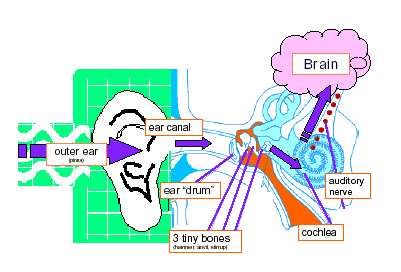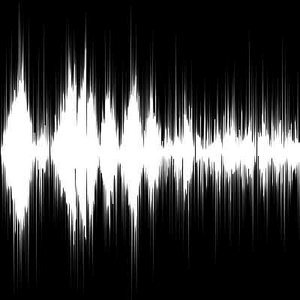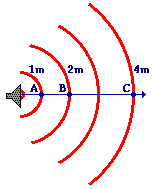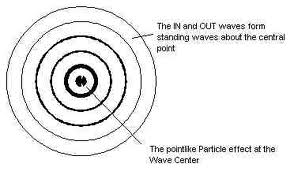INTRODUCTION: SOUND
Before we can talk about music specifically, we have to talk about sound in general.
 |
SOUND is defined as the displacement of a medium, such as gas or liquid. In other words, when an object moves in air or water, the particles of the air or water that move are what creates the sound. These movements cause the tempranic membrane in the ear to vibrate, which is conveyed to the brain by the auditory nerve, and the sensation of hearing a sound occurs, as shown in the diagram. But we're more concerned with what happens before the sound hits your ear, since the body's response to sound isn't really all that interesting to physics. Also, is it worth mentioning that this is not specific to sound moving through air. When you go swimming, you can probably hear muffled sounds underwater. This tells us that when water is displaced, sound still occurs. |
| Diagram courtesy of the
National Foundation for the Deaf, NFD.org |
HOW SOUND TRAVELS THROUGH AIR
Since this medium is what we're primarily concerned with, this is what we'll focus on.
 |
Sound moves through air
generally as our intuition tells us
it would. Our experiences with many devices have probably allowed us to
see things like this picture to the left. This graphical representation of sound seems logical: the taller the spike, the louder the sound. We can also reason that the sound varies since the shape of the wave changes. It allows us to give the way that sound moves in air to take a visual form- even though we know we can't actually see sound moving through the air. Being able to understand how sound moves through air allows us to do a lot of pretty cool things. Some of which include: -understanding the lighting rule to find out how far away a storm is (counting the seconds between lightning and thunder) -using SONAR to figure out how far away and where an obstacle is -calculating how fast an object that is moving and creating constant sound is going -understanding how ultrasound technology works |
| Picture courtesy of: http://www.prntscreen.net/itpblog/softness_of_things/assignments_3/ | |
 http://www.physicsclassroom.com/class/sound/u11l2b.cfm |
 Sound waves are known as SPHERICAL
waves. This means
that they move in, you guessed it, spherical motions. The diagram to
the right is a birds' eye view of this motion. However, this is only in
two dimensions. This motion is also expanded into the vertical axis.
(This means that the waves would also be traveling from the particle
into the screen and out of the screen in similar fashions). Sound waves are known as SPHERICAL
waves. This means
that they move in, you guessed it, spherical motions. The diagram to
the right is a birds' eye view of this motion. However, this is only in
two dimensions. This motion is also expanded into the vertical axis.
(This means that the waves would also be traveling from the particle
into the screen and out of the screen in similar fashions).The diagram to the right shows the motion of sound that is spherical, but has been aimed in a certain direction via the conical shape of the speaker's back. This picture courtesy of http://www.spaceandmotion.com/Wolff-Wave-Structure-Matter.htm |
Sound waves are LONGITUDINAL waves: this means that they travel in an even more specific way. That is, we can break down how each individual ring in the wave's motion moves.
The video below, courtesy of youtube.com, will explain how exactly this wave "looks"
and acts for a better understanding of the phenomenon of sound.
(In the case that the video cannot load, select the "watch on YouTube" option)